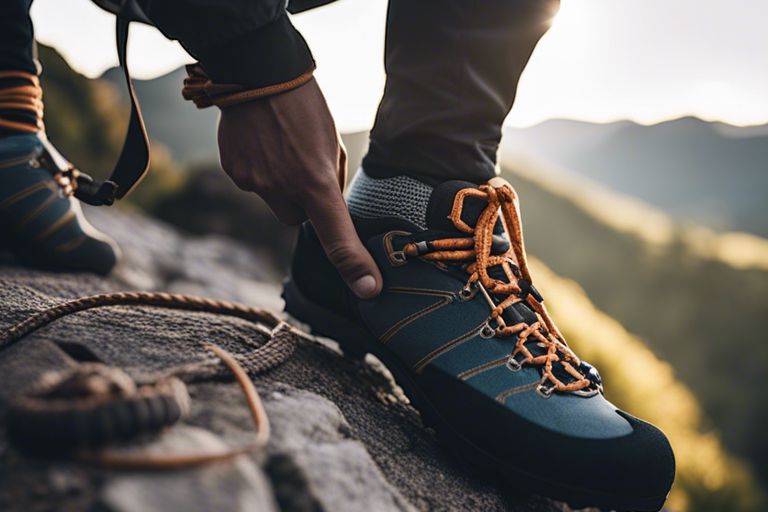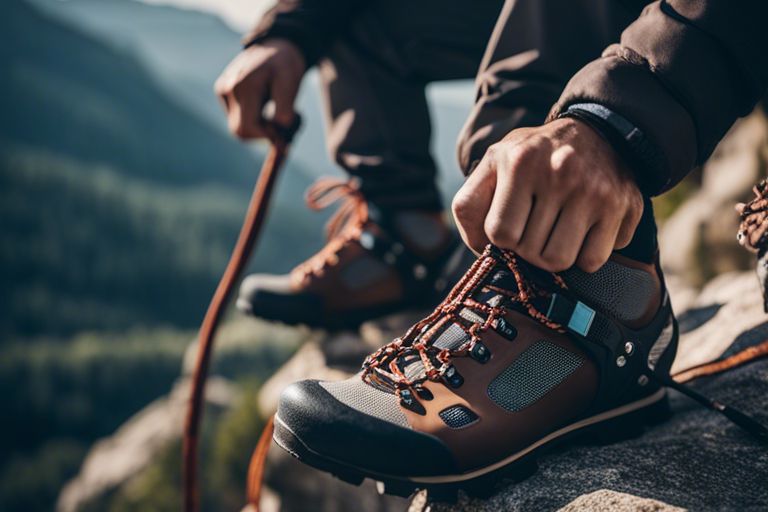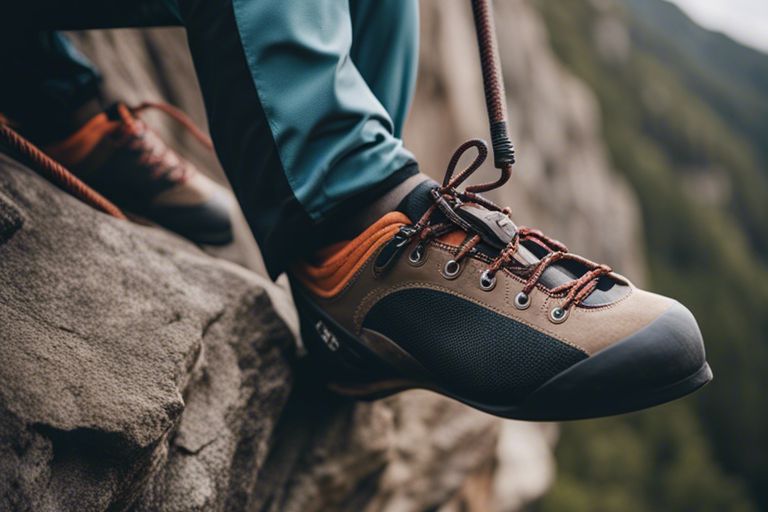Before you hit the rocks, consider the age-old dilemma: socks or no socks with climbing shoes? In this informative piece, we unpack the pros and cons of each choice so you can make an informed decision based on your climbing style and comfort preferences. Whether you’re a seasoned pro or a newbie on the wall, find out which option suits you best and why.
Key Takeaways:
- Comfort: Wearing socks with climbing shoes can provide added comfort and cushioning, reducing the likelihood of blisters or hot spots.
- Fit: Socks can alter the fit of climbing shoes, potentially affecting performance and precision in climbing movements.
- Personal Preference: Ultimately, whether to wear socks with climbing shoes is a matter of personal preference, with some climbers preferring the added comfort of socks while others prefer the increased sensitivity of barefoot climbing.

The Importance of Climbing Shoes
Why Climbing Shoes Matter
An important piece of equipment for any climber is a good pair of climbing shoes. Your climbing shoes are your connection to the rock, providing you with the grip and support needed to navigate the challenging terrain. They are specially designed to help you feel the rock and make precise movements, enhancing your performance on the wall.
Benefits of Wearing Climbing Shoes
Climbing shoes offer several benefits that can make a significant difference in your climbing experience. They are snug-fitting, providing a secure fit that allows you to confidently stand on small edges and footholds. Additionally, the sticky rubber soles of climbing shoes offer excellent traction, helping you feel more secure on the rock. Wearing climbing shoes can also help improve your footwork technique, as the snug fit encourages you to be more precise with your movements.
Shoes made specifically for climbing also have a downturned shape, which helps you apply more pressure to your toes when standing on tiny holds. This design feature can give you a competitive edge on difficult climbs, allowing you to access footholds that would be challenging in regular shoes.
Socks and Climbing Shoes: A Debate
The Case for Wearing Socks
For some climbers, wearing socks with climbing shoes is a matter of personal preference. Socks can provide comfort by reducing friction between your feet and the shoes, which can help prevent blisters and hot spots during long climbing sessions. Additionally, socks can absorb sweat, keeping your feet drier and potentially reducing the risk of developing fungal infections.
The Case Against Wearing Socks
Wearing socks with climbing shoes can reduce sensitivity and make it harder to feel the rock beneath your feet, affecting your ability to make precise movements. Without direct contact, you might struggle to trust your footing, especially on more technical climbs where every small edge matters. Some climbers prefer the snug fit of shoes against bare skin, allowing them to maximize their control and feel on the rock.
Case in point, the choice of whether to wear socks with climbing shoes ultimately comes down to personal preference and the type of climbing you are doing. Consider trying both methods to see what works best for you and the specific demands of your climbing style.
Factors to Consider
Once again, the decision of whether to wear socks with climbing shoes is a personal one and can be influenced by various factors. Here are some things to consider:
Personal Preference
To start, your personal preference plays a significant role in determining whether or not you wear socks with your climbing shoes. Some climbers prefer the added comfort and moisture-wicking properties that a good pair of climbing socks can provide. Others find that wearing socks diminishes sensitivity and precision when climbing.
It’s important to try out different options and determine what feels best for you. Your comfort and performance on the rock are paramount, so choose the option that allows you to climb your best.
Climbing Style
One factor to consider is your climbing style. If you engage in more technical climbing that requires precise footwork and sensitivity, you may prefer to go without socks to maximize connection and feel with the rock.
With aggressive bouldering or sport climbing where power and precision are crucial, some climbers find that going sockless helps them maintain a better grip and control on small footholds.
Environmental Conditions
With changing environmental conditions, the choice of wearing socks with climbing shoes can also vary. In colder weather, socks can provide insulation and keep your feet warm, allowing you to climb comfortably. On the other hand, in hot and humid conditions, socks can add an extra layer of warmth that may lead to sweaty feet and discomfort.
It’s crucial to consider the temperature, humidity, and terrain before deciding whether to wear socks with your climbing shoes. Your comfort and safety on the wall should always be a priority.

Pros and Cons of Wearing Socks with Climbing Shoes
Despite the debate surrounding whether to wear socks with climbing shoes, there are both pros and cons to consider. To help you make an informed decision, let’s break down the advantages and disadvantages of wearing socks with your climbing shoes in the table below.
| Pros | Cons |
|---|---|
| Comfort | Reduced Sensitivity |
| Blister Prevention | Reduced Performance |
Pros: Comfort and Blister Prevention
Socks can provide an extra layer of cushioning and padding between your feet and the climbing shoes, which can enhance overall comfort, especially during long climbing sessions. Additionally, wearing socks can help prevent blisters by reducing friction and absorbing sweat.
Socks can provide an extra layer of cushioning and padding between your feet and the climbing shoes, which can enhance overall comfort, especially during long climbing sessions. Additionally, wearing socks can help prevent blisters by reducing friction and absorbing sweat.
Cons: Reduced Sensitivity and Performance
Socks may decrease the sensitivity you have on the rock surface, making it harder to feel small holds and nuances in the terrain. This reduced sensitivity can impact your overall performance and climbing ability, especially in more technical climbs where precision is crucial.
Blister formation can also be a concern when wearing socks with climbing shoes, as the extra layer of fabric can sometimes bunch up or create pressure points, leading to discomfort and potential blister development.
Expert Opinions
Professional Climbers’ Perspectives
To get a better understanding of whether to wear socks with climbing shoes, you should consider the opinions of professional climbers. Many experienced climbers prefer not to wear socks with their climbing shoes. They believe that wearing socks can reduce the sensitivity and precision needed for challenging climbs. Without socks, your feet are directly in contact with the shoe, allowing you to feel the rock better and make more precise movements.
Guides and Instructors’ Insights
With years of experience teaching climbing techniques, guides and instructors offer valuable insights on the topic. While some instructors may recommend wearing thin socks with climbing shoes for added comfort, many suggest going without socks to enhance sensitivity and grip. Climbing without socks can also help prevent moisture buildup inside the shoes, reducing the risk of blisters and improving overall foot stability while climbing.
Guides often advise climbers to choose a snug-fitting pair of climbing shoes that provide a balance between comfort and performance. This means finding a shoe that molds to your foot shape without the interference of socks, allowing for better control and technique during climbs.

Making the Right Choice
Assessing Your Climbing Needs
For making the right choice when deciding whether to wear socks with your climbing shoes, it’s important to assess your climbing needs. Consider the type of climbing you’ll be doing, as well as the fit and feel that you prefer when wearing climbing shoes. Some climbers prefer the snug feel of climbing shoes without socks for better sensitivity and control, especially in more technical climbs. Others may prioritize comfort and moisture-wicking capabilities that socks can provide, especially during long climbing sessions.
Experimenting with Different Options
One way to determine whether wearing socks with climbing shoes is right for you is to experiment with different options. Try climbing with and without socks on different climbs to see how each feels for you personally. Pay attention to how wearing socks impacts your performance, fit, and comfort levels. Some climbers find that socks can help prevent blisters and hotspots, while others feel they reduce sensitivity and precision. Finding the right balance for your climbing needs may involve some trial and error.
Needs
Ultimately, the choice of whether to wear socks with climbing shoes comes down to your personal preferences and comfort. By assessing your climbing needs and experimenting with different options, you can make an informed decision that helps you perform at your best on the rock.
Summing up
Upon reflecting on whether or not to wear socks with climbing shoes, it ultimately comes down to personal preference and comfort. Some climbers swear by the added protection and cushioning that socks provide, while others prefer the direct contact with the rock that comes from climbing barefoot. It’s important to try out both options and see what works best for you and your climbing style.
Do not forget, the most important thing is to feel confident and secure in your climbing shoes, whether you choose to wear socks or not. Experiment with different combinations and find what feels most comfortable and supportive for you. Happy climbing!
Q: Is it necessary to wear socks with climbing shoes?
A: It is not necessary to wear socks with climbing shoes. Most climbers choose to wear their shoes without socks to improve sensitivity and feel on the rock.
Q: Can wearing socks with climbing shoes prevent blisters or discomfort?
A: Some climbers prefer to wear thin socks with climbing shoes to prevent blisters and increase comfort, especially during long climbing sessions. However, this may slightly reduce sensitivity and precision.
Q: What factors should I consider when deciding whether to wear socks with climbing shoes?
A: When deciding whether to wear socks with climbing shoes, consider factors such as personal preference, type of climbing activity, shoe fit, foot sensitivity, and comfort. It is recommended to try both with and without socks to see what works best for you.




